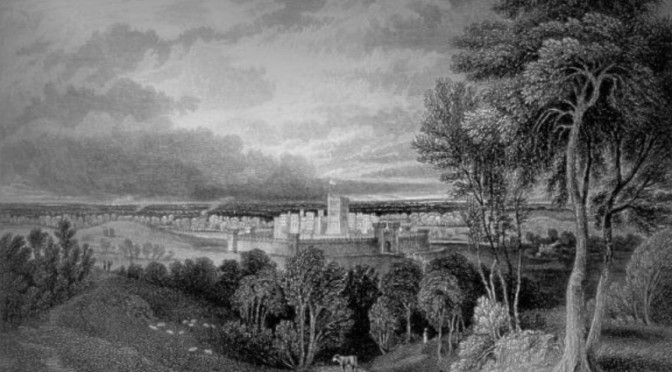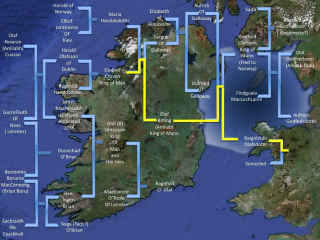 John Stanley was not the only candidate under consideration for the King of Man. There was in fact a better candidate. This time the descent led through Olaf the Red and Somerled.
John Stanley was not the only candidate under consideration for the King of Man. There was in fact a better candidate. This time the descent led through Olaf the Red and Somerled.
A second thread lies through Somerled himself back through the descendants of Brian Boru and the kings of Norway.
This candidate was Isabel de Lathom .
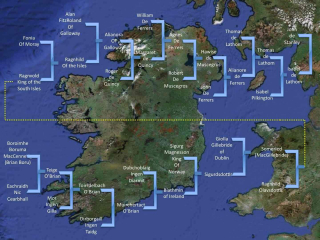 No mention of this finds its way into the Seacome history in the annals of the Isle of Mann which indicates that the service as Lord Lieutenant in Ireland and the subsequent elevation to Royalty were simply rewards for service to the king.
No mention of this finds its way into the Seacome history in the annals of the Isle of Mann which indicates that the service as Lord Lieutenant in Ireland and the subsequent elevation to Royalty were simply rewards for service to the king.
In fact Isobel Lathoms claim was a very good one. It was grounded in Godfred Craven but progressed though the marriage of his daughter to Somerled, thus combining the two factions of the kingship of Mann.
It was perhaps a measure of the determination of the English Crown to create and independent Mann that for a fourth time a candidate was sought who would be acceptable to the Manx people.
Isabel de Lathom
Someone did their homework very carefully. Isabel de Lathom was descended from the kings of Mann. As a woman however she would not have been acceptable to this Viking community.
With the right husband however she could pass on those rights to a son.
No mention of this finds its way into the Seacome history in the annals of the Isle of Mann.
 In fact Isobel Lathoms claim was a very good one. It was grounded in Godfred Craven but progressed though the marriage of his daughter to Somerled, thus combining the two factions of the kingship of Mann.
In fact Isobel Lathoms claim was a very good one. It was grounded in Godfred Craven but progressed though the marriage of his daughter to Somerled, thus combining the two factions of the kingship of Mann.
 A second thread lies through Somerled himself back through the descendants of Brian Boru and the kings of Norway.
A second thread lies through Somerled himself back through the descendants of Brian Boru and the kings of Norway.
 Isabel's '" unlawful" marriage to Geoffrey
Isabel's '" unlawful" marriage to Geoffrey
This leads to the true story of Isabelle de Lathom. unfortunately she was married to the wrong husband!
It took years of ferreting to try to understand exactly what happened. What I learned is now all available on the web, though so far it has not been picked up by any of the geneologies.
The results were surprising to say the least.
There is no doubt that Isabel became John’s wife. Seacome suggests that her father thought he was an unsuitable match, thus explaining why John married so late in life. This story is supported by all the available histories.
However I have taken the trouble to look at the parish records of Lathom which shows that she also had an earlier marriage, to Geoffrey Worsley which was subsequently declared “unlawful”.
Further examination of the Worsley parish records shows and that she had at least one child, Elizabeth, by him. Not only that but the marrige was decidedly unusual. Geoffrey put his first wife, Mary de Fenton, in a nunnery and then married Isabel. After five years, he died. Mary re-emerged from the nunnery claimed her marriage to be valid and succeeded in having Isabel’s children declared illegitimate and therefore destroyed Isabel’s reputation.
However events were moving quickly. Sir Thomas, Isabel’s father had previously left his estates to an “adopted” son known as Sir Oscatel. Now he suddenly declared that that in the event of his sons not having a male heir, the estates should devolve to Isabel. His two sons died soon afterwards. It was at this stage that John Stanley married Isabel. So much for the romantic stories!
Arthur Worsley
 Elizabeth's forced marriage to ArthurThe story progresses further. From the history of the British Parliament (1386-1421) it can be discovered that Robert Worsley, a member of the junior branch of the Worsley family, somehow obtained Elizabeth’s wardship with the intention of forcing her marriage to his son Arthur and thereby establishing a claim to the Worsley estates (and perhaps with an eye to claiming the Lathom estates).
Elizabeth's forced marriage to ArthurThe story progresses further. From the history of the British Parliament (1386-1421) it can be discovered that Robert Worsley, a member of the junior branch of the Worsley family, somehow obtained Elizabeth’s wardship with the intention of forcing her marriage to his son Arthur and thereby establishing a claim to the Worsley estates (and perhaps with an eye to claiming the Lathom estates).
The marriage was affected in 1400 ( with Elizabeth at 19 years of age), but John Stanley Jr ( at Age 16!?) in 1402 as crown commissioner managed to get Arthur declared insane.
In 1414 after the death of his father John II then obtained the custody of Arthur Worsley who died “in his care” thereby finally ending any threat to the Stanley inheritance.
Suddenly at the very beginning of my research, Aunt Gertude’s story aquires sinister overtones.
There is not a word of all this in Seacome, the Isle of Mann archieves or any other formal history. Seacome was a serious historian who must have known all this. The information was therefore changed to suit the sensitivities of the Stanley Family.
It was about this stage that I developed a healthy scepticism for “approved” histories!
The Eagle and Child
 Was Sir Ocatel a real person? the candidates as indicated in red. Note the name of Ralph's son. Oscatel /Otewell?A secondary story of the foundation of the Stanley Dynasty, which is included in the Seacome history is the backgtound to the adopted son Sir Oscatel. It takes the form of the legend of the Eagle and Child.
Was Sir Ocatel a real person? the candidates as indicated in red. Note the name of Ralph's son. Oscatel /Otewell?A secondary story of the foundation of the Stanley Dynasty, which is included in the Seacome history is the backgtound to the adopted son Sir Oscatel. It takes the form of the legend of the Eagle and Child.
The legend says that Isabelle’s father, Sir Thomas, had an affair with a lady called Mary Oscatel who gave birth to a male child. He had no male child by his wife and so pretended that an eagle had deposited the child in his estate, giving him an excuse to bring the child into his house in circumstances which made the child acceptable to his wife.
Wether she believed the story or not, Thomas’ wife apparently approved of this arrangement as it would stabilise the future administration of the estate. She then promptly concieved a male child herself but “Sir Oscatel” apparently grew up with expectations that as the eldest son he would inherit the Lathom estates.
Sir Robert’s will was contested and on his deathbed Isabelle’s father relented and subject to there being no male issue from his second son made Isabelle his heir.
The inheritance of the Lathom estates continued to be contested from the date John Stanley married Isabel in 1385 to around 1409.
I have made “Sir Oscatel” to be John II who was hidden away under a non de plume on the Lathom estates to keep him safe from those who wished to destroy Ximene. Why did the Lathoms accomodate her in this deception and invent the legend?
Because as shown above in the “conventional” geneology John Stanley’s grandmother was a Lathom!
The inheritance of the Lathom estates was not finally settled until John II inherited in 1414. At that time John II was probably the rightful inheritor but through his father not his mother. There was the small problem that he was probably illigimate, but there were events in the highest levels of society which made that less of a problem than it was in any other age. John of Gaunt not only married the illegitimate daughter of Pedro of Castile and through her claimed the throne of Castile but had his illegitimate children by another woman, Catherine de Roet, declared to be legitimate. John II had a strong claim, but so did Henry and Thomas Stanley, Isabel’s sons by John. It would appear that the final judgement was that by virtue of his marriage to Isabel John became heir to the Lathom estates and therefore his eldest son inherited, even though his eldest son was by a different Mother. No wonder the inheritance to a long time to sort out!
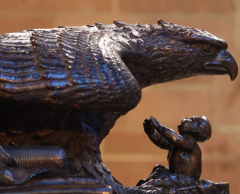 From Knowsley house. The eagle as a benefactor.As all this information was digested, The plot for this stories about Ximene evolved to make Ximene the frenchwoman, who John meets when in Occitan with the Black Prince in 1355 and 1356 and who is the mother of John II. It also casts Ximene as the personification of the Eagle, seen by later generations of Stanley’s as the facilitator of the founding of their dynasty.
From Knowsley house. The eagle as a benefactor.As all this information was digested, The plot for this stories about Ximene evolved to make Ximene the frenchwoman, who John meets when in Occitan with the Black Prince in 1355 and 1356 and who is the mother of John II. It also casts Ximene as the personification of the Eagle, seen by later generations of Stanley’s as the facilitator of the founding of their dynasty.
A statue from the family home at Knowsley, in Lancashire, clearly depicts the Eagle as a Guardian or Protector.
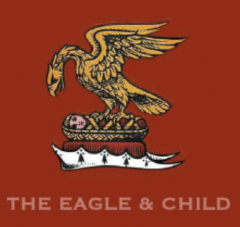 The pub signs frequently show the Eagle as a threatThe Eagle was not however seen through the same eyes by the Lathom family into which John eventually married, or the rest disinherited Stanley family. Neither group ever forgot that the wealth of the later Stanleys was founded on the Lathom estates.
The pub signs frequently show the Eagle as a threatThe Eagle was not however seen through the same eyes by the Lathom family into which John eventually married, or the rest disinherited Stanley family. Neither group ever forgot that the wealth of the later Stanleys was founded on the Lathom estates.
Many Public houses in the north of England and one famous inn in Oxford are called the Eagle and Child. Most of the pub signs, appear to show the Eagle as a predator, threatening the child.
